Kiss of the Vampire (1963)
Directed by: Don Sharp
Written by: Anthony Hinds
Starring: Clifford Evans, Edward de Souza, Jennifer Daniel, Noel Willman
UK
AKA KISS OF EVIL
AVAILABLE ON BLU-RAY [REGION ‘B’ ONLY] AND DVD
RUNNING TIME: 88 min
REVIEWED BY: Dr Lenera, Official HCF Critic

Just outside a Bavarian village, a funeral is interrupted by the heavy drinking Professor Zimmer who, knowing the presence of a vampire, kills the creature inside. Gerald and Marianne Harcourt are honeymooning in the area but, watched from afar by Dr. Ravna from his chateau, their car breaks down and they have to stay at the village inn, a place which for some reason seems to have no guests and the husband and wife owners have recently lost a loved one. A letter arrives for the Harcourt’s from Ravna, inviting them to join him for dinner. Ravna seems quite the charming host and, despite Marianne almost falling into a trance when one of his sons plays the piano, the evening goes well, but they then run into Zimmer who tells them some home truths about Ravna….
Not quite a classic Hammer horror movie but a neat little vampire tale nonetheless, I used to confuse Kiss Of The Vampire with The Brides Of Dracula when I was first getting into these films as a youngster and distinctly recall watching one of the two films [I’m not sure which one] and being disappointed that some great bits I’d supposedly remembered from it seemed to be missing. Viewing the film last night revealed it to be a bit different in style and approach, and it has a few good ideas in its own right, yet it still comes across as a companion piece to the earlier film without really copying much from it. Aside from a few moments, it’s rather lacking in the required Gothic atmosphere and is quite light on the horror too, the film having more the feel of a slow burning suspense thriller at times, while its plot is rather thinly stretched over its running time, but Don Sharp’s mostly very restrained, but quite lavish looking and pretty well acted [from a not-very-well-known cast] first Hammer effort is rather entrancing and tries to avoid some of the typical vampire cliches in a way that the later Hammer Draculas struggled to do, even if they were usually more entertaining and horror-orientated pictures.
It was Universal, pleased with the box office returns from The Brides Of Dracula, who asked for another film from Hammer in a very similar vein. It was easy for Anthony Hinds to write the screenplay as he borrowed quite a bit from Jimmy Sangster’s original script for what became The Brides Of Dracula which was called Disciple Of Dracula, including the opening and closing scenes which weren’t used, the latter mainly because Peter Cushing didn’t like the idea of Van Helsing using black magic to destroy evil. Amidst rumours that Terence Fisher was out of favour due to The Phantom Of The Opera flopping, Sharp’s first job as director was to rewrite the script to remove most of the scenes of graphic bloodshed. Hammer decided to go without both Cushing and Christopher Lee, and saved more money by buying the rubber bats used in the climax from Woolworths, with an addition of just a few models for close-ups. Said climax lost a few seconds due to the BBFC before the film was released, eventually, on a very successful double bill with Paranoiac. Even the reviews for this one were quite good. The US version, for some reason, lost the beginning scene and the release was held up for several months by Universal who were concerned that the climax contained similar footage to The Birds. A US TV version entitled Kiss Of Evil cut anything even slightly unsuitable for a child and added footage of a family whose daughter takes up with Ravna. I always hope that one day we’ll get a release of the film which will have this material, but it hasn’t happened so far, even on the UK Blu-ray.
The beginning is really striking with a memorable first shot of only the top halves of people from a funeral procession seen walking the other side of some tree trunks, then a quite lengthy ceremony which is rudely interrupted by the very soused Professor Zimmer who suddenly plunges a spade into the coffin [I’d have loved to have seen Cushing do this], we hear a female scream, and then see blood pouring out. After the credits, which as with some other Hammers of the time are set in front of a large face, we meet our main couple and get the film’s most atmospheric scene as Gerald goes off to get help and Marianne is left alone in the woods. Black Park was probably never made so eerie as the wind and lovely photography help create a nice sense of unease in broad daylight. The couple soon find themselves at an inn, but aren’t there for long as they’re driven to Ravna’s chateau which was obviously built by the same folk who constructed Castle Dracula. There’s another fine scene where Marianne is hypnotised by one of Ravna’s sons playing the piano, and an even better one a bit later when the couple attend a masked ball at the castle, a scene which really looks quite expensive and was copied by Roman Polanski in Dance Of The Vampires. Polanski did it better, but then he had the time and money to do so.
The film then almost seems to become a different one altogether as Gerald awakes to find his wife disappeared, with everyone denying her existence and no evidence that she was in either the inn or the chateau. This Lady Vanishes-type stuff doesn’t quite create the suspense that it should do and would have worked better if it had occurred nearer the beginning of the film where we wouldn’t already know everything that is actually going on. Zimmer appears every now again to demand more [he “lives on brandy or sour cream” says the innkeeper] or encounter a vampire, but, despite Clifford Evans playing the part with considerable conviction, it’s hard to take the constantly blotto character too seriously even when you find out the reason for his pain. Like The Brides Of Dracula, Kiss Of The Vampire spends a bit too long on build-up and not enough on execution, with the film deciding to suddenly rush to a climax, but Zimmer’s use of sorcery to destroy the vampires is an interesting concept and foreshadows The Devil Rides Out in some of its aspects. As for the big bat attack; no, it doesn’t make any sense [vampires done in by vampire bats!] and looks pretty rough nowadays but is not bad for its time really and has some surprising nasty bits, the bats even seen going for breasts and between women’s legs. Elsewhere the film tends to cut away from the blood or violence, some bits suffering a bit from this and others not, such as when Sharp, instead of letting us see Ravna biting Marianne, has his face move closer and closer to the camera and he seems to bite the audience!
Kiss Of The Vampire leaves quite a bit that is vague, such as some of the details about the process of vampirism in it [it seems to imply that after just one bite a human is with the vampires but not yet a vampire….or something], but it’s always nice to have an actual vampire family and the film’s depiction of its bloodsucking group as an almost Charlie Manson-cult in white robes is interesting, while much of the traditional vampire lore is avoided. There aren’t even any stakes. There’s a nice and oddly touching little moment when one of the vampires goes to another’s grave and asks: “Why have you not been to see us my dear”?, before finding Ravna’s spade in her friend’s dead body, which makes me wish the film had tried to portray its vampires a bit more sympathetically elsewhere. Sometimes The Kiss Of The Vampire seems on the verge of being a really interesting vampire film, and certainly contains some good elements of subtext like the class commentary Hammer would sometimes indulge in [vampires – rich folk sucking the life out of the poor], but tends to stop short just when you feel it’s really going to take off. Something which is a flaw with the quickly and cheaply made [though often great looking] Hammer product I suppose, even though I’m finding some of these films to be even better when seen through an older and more critical eye than as I remembered them. Bernard Robinson’s sets in this one are certainly amazingly plush and ornate; this guy really knew how to stretch a budget as far as anyone, while at times you’d still think Fisher directed this film given the way many scenes are shot [though early shakycam makes an effective appearance when Gerald is drunk] and cinematographer Alan Hume really goes for the Jack Asher look in places with some especially striking moments when green is used, though elsewhere he often seems to attempt a more realistic look.
Edward de Souza is certainly better here than he was in The Phantom Of The Opera and Jennifer Daniel is so effective as a Mina Harker type that I wish she’d played that character in a straight Dracula adaptation. I’ve already praised Evans, but he’s almost matched by Noel Willman, who is suitably suave but also subtly seems to hint at the despair of the vampire existence without laying it on. James Bernard’s score is for much of the time one of his simpler efforts, though I’ve come to the conclusion that he matches Bernard Herrmann in his use of simple, tiny semi-‘themes’ and chord progressions, but his Liszt-like vampire rhapsody for piano, which forms the basis for almost the whole score, is a great creation which may remain in your head for some time. I didn’t used to think very much of this one, and it still doesn’t entirely come off, but it contains much to enjoy, and also rather oddly feels like it was made about ten years later than it actually was, which is a good thing I suppose….though Hammer’s greatest non-Dracula vampire movie was still a long way off….
Rating: 










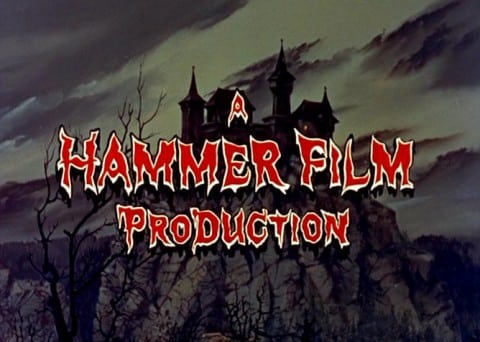

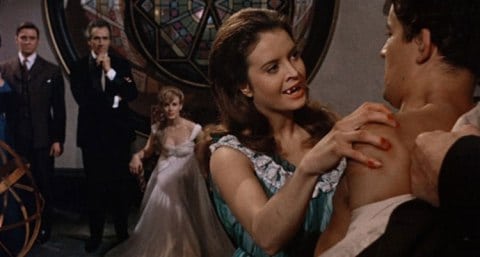

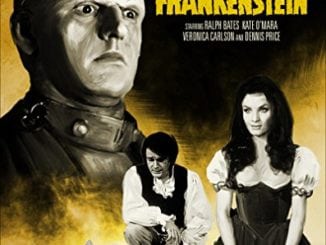
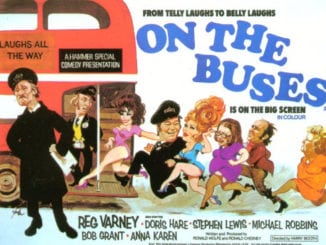
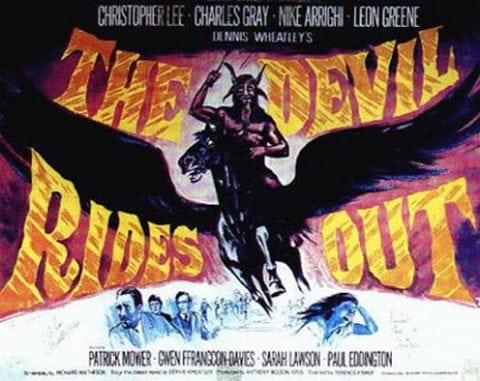
Be the first to comment